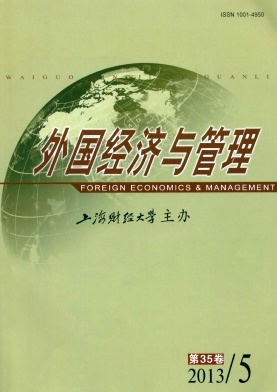基于社会网络视角的多边联盟研究与概念框架构建
外国经济与管理 2013 年 第 35 卷第 05 期, 页码:60 - 71
摘要
参考文献
摘要
本文在梳理现有战略联盟研究的基础上,首先阐述了多边联盟研究的重要意义,并且对现有的多边联盟研究文献进行了述评;然后基于社会网络视角系统探讨了多边联盟的形成、治理及演化等问题;最后构建了社会网络视角下的多边联盟研究概念框架,并且指出了多边联盟研究可进一步深入的方向。
[1]Ahuja G.The duality of collaboration:Inducements and op-portunities in the formation of interfirm linkages[J].Strategic Management Journal,2000,21(3):317-343.
[2]Arino A and Ring P S.The role of fairness in alliance forma-tion[J].Strategic Management Journal,2010,31(10):1054-1087.
[3]Brass D J,et al.Taking stock of networks and organizations:A multilevel perspective[J].Academy of Management Jour-nal,2004,47(6):795-817.
[4]Burt R S.Structural holes:The social structure of competition[M].Cambridge,MA:Harvard University Press,1992.
[5]Choi T Y and Wu Z.Triads in supply networks:Theorizing buyer-supplier-supplier relationships[J].Journal of Supply Chain Management,2009,45(1):8-25.
[6]Chung C C and Beamish P W.Multi-party international joint ventures:Multiple post-formation change processes[J].Jour-nal of World Business,2012,47(4):648-663.
[7]Chung S,et al.Complementarity,status similarity and social capitals as drivers of alliance formation[J].Strategic Manage-ment Journal,2000,20(1):1-22.
[8]Das T K and Teng B.Alliance constellations:A social ex-change perspective[J].Academy of Management Review,2002,27(3):445-456.
[9]Das T K and Teng B.Partner analysis and alliance perfor-mance[J].Scandinavian Journal of Management,2003,19(3):279-308.
[10]De Man A P and Duysters G.Collaboration and innovation:A review of the effects of mergers,acquisitions and alliances on innovation[J].Technovation,2005,25(12):1377-1387.
[11]Doz Y L,et al.Formation processes of R&D consortia:Which path to take?Where does it lead?[J].Strategic Mana-gement Journal,2000,21(3):239-266.
[12]Eisenhardt K M and Schoonhoven C B.Resource-based view of strategic alliance formation:Strategic and social effects in entrepreneurial firms[J].Organization Science,1996,7(2):136-150.
[13]Ekeh P P.Social exchange theory:The two traditions[M].Princeton,NJ:Princeton University Press,1974.
[14]Garcia-Canal E,et al.Effectiveness of dyadic and multipartyjoint ventures[J].Organization Science,2003,24(5):743-770.
[15]Granovetter M.Economic action and social structure:The problem of embeddedness[J].American Journal of Sociology,1985,91(3):481-510.
[16]Gulati R.Alliances and networks[J].Strategic Management Journal,1998,19(4):293-317.
[17]Hansen M H,et al.Competitive advantage in alliance gover-nance:Resolving the opportunism minimization-gain maximi-zation paradox[J].Managerial and Decision Economics,2008,29(1):191-208.
[18]Hennart J.Alliance research:Less in more[J].Journal of Management Studies,2006,43(7):1621-1628.
[19]Kilduff M and Tsai W.Social networks and organizations[M].London:Sage Publications,2003.
[20]Lavie D,et al.The performance of implications of timing of entry and involvement in multi-partner alliances[J].Academy of Management Journal,2007,50(3):578-604.
[21]Li D,et al.Friends,acquaintances or strangers?Partner se-lection in R&D alliances[J].Academy of Management Jour-nal,2008,51(2):315-334.
[22]Li D,et al.Governance in multilateral R&D alliances[J].Or-ganization Science,2012,23(4):1191-1210.
[23]Li D.Multilateral R&D alliances by new ventures[J].Jour-nal of Business Venturing,2013,28(1):241-260.
[24]Ness H.Governance,negotiations and alliance dynamics:Ex-plaining the evolution of relational practice[J].Journal of Management Studies,2009,46(3):451-480.
[25]Ozcan S and Overby M L.A cognitive model of stock market reactions to multi-firm alliance announcements[J].Strategic Organization,2008,6(4):435-469.
[26]Ozcan P and Eisenhardt K M.Origin of alliance portfolios:Entrepreneurs,network strategies and firm performance[J].Academy of Management Journal,2009,52(2):246-279.
[27]Sakakibara M.Formation of R&D consortia:Industry and company effects[J].Strategic Management Journal,2002,23(11):1033-1050.
[28]Simmel G.The number of members as determining the socio-logical form of the group[J].American Journal of Sociology,1902,8(1):1-46.
[29]Thorgren S,et al.Too small or too large to trust your part-ners in multi-partner alliances?The role of effect in initia-ting generalized exchanges[J].Scandinavian Journal of Man-agement,2010,27(1):99-112.
[30]White S.Cooperation costs,governance choice and alliance e-volution[J].Journal of Management Studies,2005,42(7):1383-1412.
[31]Yin X,et al.When unconnected others connect:Dose degree of brokerage persist after the formation of a multi-partner alli-ance?[J].Organization Science,2012,23(6):1682-1699.
[32]Zeng M and Chen X P.Achieving cooperation in multiparty alliances:A social dilemma approach to partnership manage-ment[J].Academy of Management Review,2003,28(4):587-605.
[33]彭伟,符正平.国外联盟研究脉络梳理与未来展望[J].外国经济与管理,2011,(12):49-57.
[2]Arino A and Ring P S.The role of fairness in alliance forma-tion[J].Strategic Management Journal,2010,31(10):1054-1087.
[3]Brass D J,et al.Taking stock of networks and organizations:A multilevel perspective[J].Academy of Management Jour-nal,2004,47(6):795-817.
[4]Burt R S.Structural holes:The social structure of competition[M].Cambridge,MA:Harvard University Press,1992.
[5]Choi T Y and Wu Z.Triads in supply networks:Theorizing buyer-supplier-supplier relationships[J].Journal of Supply Chain Management,2009,45(1):8-25.
[6]Chung C C and Beamish P W.Multi-party international joint ventures:Multiple post-formation change processes[J].Jour-nal of World Business,2012,47(4):648-663.
[7]Chung S,et al.Complementarity,status similarity and social capitals as drivers of alliance formation[J].Strategic Manage-ment Journal,2000,20(1):1-22.
[8]Das T K and Teng B.Alliance constellations:A social ex-change perspective[J].Academy of Management Review,2002,27(3):445-456.
[9]Das T K and Teng B.Partner analysis and alliance perfor-mance[J].Scandinavian Journal of Management,2003,19(3):279-308.
[10]De Man A P and Duysters G.Collaboration and innovation:A review of the effects of mergers,acquisitions and alliances on innovation[J].Technovation,2005,25(12):1377-1387.
[11]Doz Y L,et al.Formation processes of R&D consortia:Which path to take?Where does it lead?[J].Strategic Mana-gement Journal,2000,21(3):239-266.
[12]Eisenhardt K M and Schoonhoven C B.Resource-based view of strategic alliance formation:Strategic and social effects in entrepreneurial firms[J].Organization Science,1996,7(2):136-150.
[13]Ekeh P P.Social exchange theory:The two traditions[M].Princeton,NJ:Princeton University Press,1974.
[14]Garcia-Canal E,et al.Effectiveness of dyadic and multipartyjoint ventures[J].Organization Science,2003,24(5):743-770.
[15]Granovetter M.Economic action and social structure:The problem of embeddedness[J].American Journal of Sociology,1985,91(3):481-510.
[16]Gulati R.Alliances and networks[J].Strategic Management Journal,1998,19(4):293-317.
[17]Hansen M H,et al.Competitive advantage in alliance gover-nance:Resolving the opportunism minimization-gain maximi-zation paradox[J].Managerial and Decision Economics,2008,29(1):191-208.
[18]Hennart J.Alliance research:Less in more[J].Journal of Management Studies,2006,43(7):1621-1628.
[19]Kilduff M and Tsai W.Social networks and organizations[M].London:Sage Publications,2003.
[20]Lavie D,et al.The performance of implications of timing of entry and involvement in multi-partner alliances[J].Academy of Management Journal,2007,50(3):578-604.
[21]Li D,et al.Friends,acquaintances or strangers?Partner se-lection in R&D alliances[J].Academy of Management Jour-nal,2008,51(2):315-334.
[22]Li D,et al.Governance in multilateral R&D alliances[J].Or-ganization Science,2012,23(4):1191-1210.
[23]Li D.Multilateral R&D alliances by new ventures[J].Jour-nal of Business Venturing,2013,28(1):241-260.
[24]Ness H.Governance,negotiations and alliance dynamics:Ex-plaining the evolution of relational practice[J].Journal of Management Studies,2009,46(3):451-480.
[25]Ozcan S and Overby M L.A cognitive model of stock market reactions to multi-firm alliance announcements[J].Strategic Organization,2008,6(4):435-469.
[26]Ozcan P and Eisenhardt K M.Origin of alliance portfolios:Entrepreneurs,network strategies and firm performance[J].Academy of Management Journal,2009,52(2):246-279.
[27]Sakakibara M.Formation of R&D consortia:Industry and company effects[J].Strategic Management Journal,2002,23(11):1033-1050.
[28]Simmel G.The number of members as determining the socio-logical form of the group[J].American Journal of Sociology,1902,8(1):1-46.
[29]Thorgren S,et al.Too small or too large to trust your part-ners in multi-partner alliances?The role of effect in initia-ting generalized exchanges[J].Scandinavian Journal of Man-agement,2010,27(1):99-112.
[30]White S.Cooperation costs,governance choice and alliance e-volution[J].Journal of Management Studies,2005,42(7):1383-1412.
[31]Yin X,et al.When unconnected others connect:Dose degree of brokerage persist after the formation of a multi-partner alli-ance?[J].Organization Science,2012,23(6):1682-1699.
[32]Zeng M and Chen X P.Achieving cooperation in multiparty alliances:A social dilemma approach to partnership manage-ment[J].Academy of Management Review,2003,28(4):587-605.
[33]彭伟,符正平.国外联盟研究脉络梳理与未来展望[J].外国经济与管理,2011,(12):49-57.
引用本文
彭伟, 符正平. 基于社会网络视角的多边联盟研究与概念框架构建[J]. 外国经济与管理, 2013, 35(5): 60–71.
导出参考文献,格式为:
下一篇:购物情境中的产品虚位现象研究述评





 7445
7445  968
968

